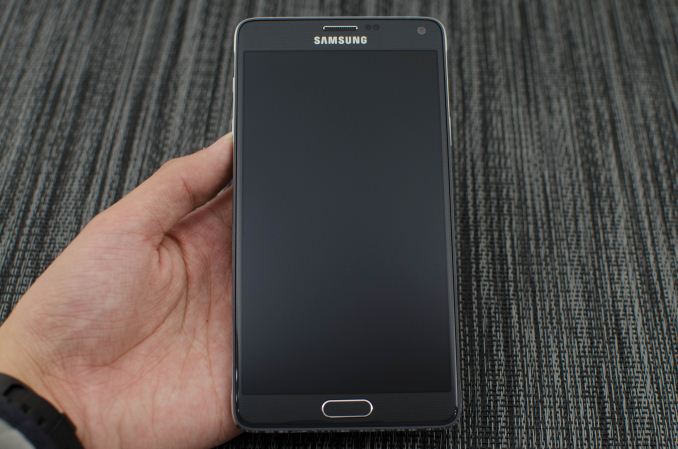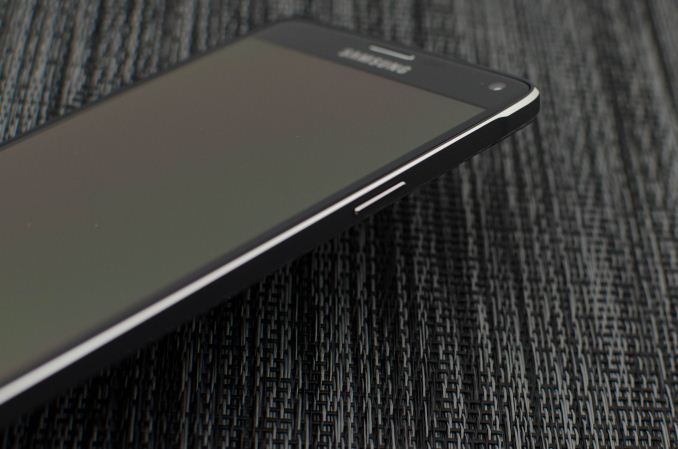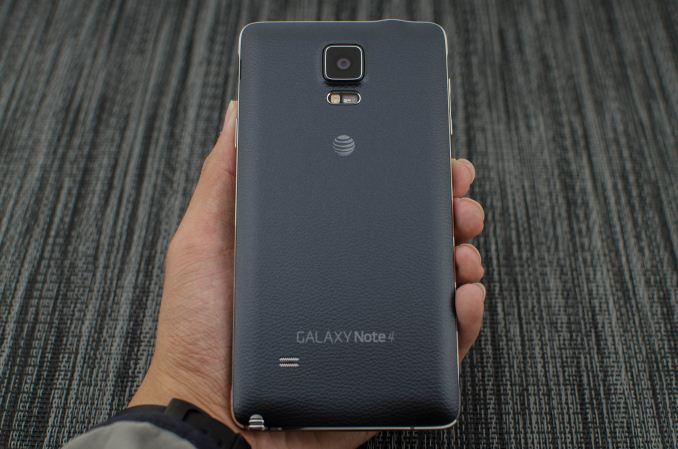The Samsung Galaxy Note 4 Review
by Joshua Ho on October 15, 2014 9:00 AM EST- Posted in
- Smartphones
- Samsung
- Android
- Mobile
- Galaxy Note 4

At this point, the Galaxy Note line needs little introduction. After all, the Galaxy Note is Samsung’s biggest success in mobile. While Apple redefined the smartphone and tablet segment, Samsung defined the phablet segment. Despite widespread skepticism, the original Galaxy Note was a massive success. Combined with the Galaxy S2, 2011 was a watershed year for Samsung as they leapfrogged other Android OEMs. Since then, we’ve seen continuous improvement from year to year with each Galaxy Note. While there were competitors, Samsung managed to hold on to their first-mover advantage for multiple generations. However, with the release of Apple’s iPhone 6 Plus we see one of the first significant threats to Samsung’s dominance of this segment.
The Galaxy Note 4 is Samsung’s latest iteration of the Galaxy Note phablet, and on the surface Samsung has put their best foot forward. With the highest bin of Qualcomm’s Snapdragon 805 or Exynos 5433, the latest generation AMOLED display, a 16MP camera with OIS, and a new design, the Galaxy Note 4 encompasses some of the best hardware that Samsung can deliver. I won’t spend too much time here, but the spec sheet below should cover most of the key points.
| Samsung Galaxy Note 3 | Samsung Galaxy Note 4 | |
| SoC | 2.26 GHz Snapdragon 800 | 2.7 GHz Snapdragon 805 |
| RAM/NAND | 3 GB LPDDR3, 32/64GB NAND + microSD | 3GB LPDDR3, 32GB NAND + microSD |
| Display | 5.7” 1080p Super AMOLED | 5.7” 1440p Super AMOLED |
| Network | 2G / 3G / 4G LTE (Qualcomm MDM9x25 IP block UE Category 4 LTE) | 2G / 3G / 4G LTE (Qualcomm MDM9x35 UE Category 6 LTE) |
| Dimensions | 151.2 x 79.2 x 8.3mm, 168 grams | 153.5 x 78.6 x 8.5 mm, 176 grams |
| Camera | 13MP Rear Facing, 1/3.06" CMOS size (Sony IMX135), 2.1MP FFC | 16MP Rear Facing w/ OIS, 1/2.6" CMOS size (Sony IMX240), F/2.0, 3.7MP FFC w/ F/1.9 aperture |
| Battery | 3200 mAh, 3.8V, 12.1 Whr | 3220 mAh, 3.85V, 12.397 Whr |
| OS | Android 4.4.2 with TouchWiz UX | Android 4.4.4 with TouchWiz UX |
| Connectivity | 802.11a/b/g/n/ac + BT 4.0, USB3.0, GPS/GNSS, MHL, DLNA, NFC | 802.11a/b/g/n/ac + BT 4.1, USB2.0, GPS/GNSS, MHL, DLNA, NFC |
| SIM Size | MicroSIM | MicroSIM |
While all of these things are easily discovered, the most immediate impressions always come from the design of the phone. In this respect, Samsung has done a surprisingly good job. On the front of the phone, we see a relatively standard design for Samsung. This entails a pattern on underneath the glass, which appears to be a bit shimmery in nature, along with dark black pinstripes. This causes a noticeable pattern in the capacitive buttons when lit, as with the LED notification light. There’s the standard earpiece and Samsung logo on top of the display, and a home button on the bottom, which serves as a fingerprint scanner as well. This home button is noticeably clicky in nature, and feels much better than the Galaxy Note 3’s home button.
On the sides, we see a similar level of improvement. The volume rocker, which is on the left side, and power button, which is on the right side, feel fantastic in comparison to most phones, and is quite close to the iPhone 6 and 6 Plus in feel. Unlike most Galaxy smartphones, we see an aluminum frame that runs all along the side of the phone, which also has a chamfered edge to eliminate sharp edges. In this area, Samsung has made serious strides as the frame really helps to make for a better in-hand feel that far exceeds what we saw with the Galaxy Note 3 or even the Galaxy S5. Along the top of the frame are cutouts for the 3.5mm headphone jack and IR port which enables TV remote functionality. Along the bottom of the frame, we see the microUSB 2.0 port. While this is technically a regression from the microUSB 3.0 port in speed and power delivery, I suspect compatibility issues and the ungainly design of the microUSB 3.0 standard justified a move back, at least until USB Type-C is ready for shipping devices.
On the back of the phone, we see some more changes. Instead of the downward-firing speakers of the Galaxy Note 3, we see that the speaker has been moved to the back of the phone. The design of the back cover is more an evolution of the Note 3’s back cover than the Galaxy S5’s, which has a noticeable faux leather pattern although the feel is closer to soft touch plastic. There’s also no stitching to try and make it seem more like leather. Instead, at the edges it seems to meet with the metal frame. A similar level of fit and finish is seen around the LED flash module, which is now flush with the back cover instead of sunk into the phone as with the Galaxy S5.
Overall, the design of the Galaxy Note 4 is massively improved. While it isn’t quite as amazing as the rounded design of the iPhone 6 and 6 Plus, it’s one of the best designs I’ve seen for a phone with a removable back cover. The only complaint I have is that Samsung should use a flat black pattern under the glass to accentuate the high contrast of the AMOLED display, but this is quite minor in nature.












195 Comments
View All Comments
akdj - Wednesday, November 12, 2014 - link
I'm sure I'm being ignorant here, but how do I 'access' that satellite display?'Best option....the one built into Qualcomm's own modem...'
Is that an option already 'built in' or an app downloaded from the Play Store? I owned the original Note and couldn't get out of it quick ebough! Contract expired, I went in to look for my next dedicated business line (the original Note's responsibilities;)) --- & about thirty seconds with the Note 3 I caved. Bought it and I've enjoyed it daily without issue for almost 14 months now. It's paid off in two, and this review leaves me curious. Especially the display & it's 'relative' efficiency maintained in essentially the same package and by doubling it's resolution.
Something to be said for these sharper, HiDPI displays ...especially for those of us with 'aging eyes' ;) --- I couldn't be happier with this resolution push, and the good riddance to 3D!
Sorry, TL/DR
What is he using as an app for that screenshot in the GPS lock tool?
Thanks
NeatOman - Wednesday, October 15, 2014 - link
Curious to see the difference in battery life between 2.4Ghz Wireless N and Wireless AC, I've noticed a significant increase with my Nexus 5, and of course it was said the rest of the tests will be up later so that's cool.skinygeek - Wednesday, October 15, 2014 - link
No Word about the Exynos Variant? I was expecting a detailed analysis of the Exynos 5433. Was the Exynos version not provided to you for review?Laxaa - Wednesday, October 15, 2014 - link
I think the Exynos variant is the international one. I guess Samsung didn't send them one as it won't be out in the US.skinygeek - Wednesday, October 15, 2014 - link
Then they should have bought it . How hard it is to get an international variant of a device. There are websites which ship you these things. I don't expect such things from other websites, but Exynos 5433 marks a new Chapter in SOC's for Android phones for being the first high end A57+A53 CPU and i was expecting Anandtech to review hat SOC given their expertise in such things .Laxaa - Wednesday, October 15, 2014 - link
Hopefully, a comparison will be made at a later date if they get a hold of such a device. I agree that it will be interesting to see how if fares.extide - Wednesday, October 15, 2014 - link
Even though it's A57/A53 it is still locked down to 32-bit only :(gunsman - Wednesday, October 15, 2014 - link
but it will allow us to better quantify the addition of ARMv8 and 64 bit once ARMv8 enabled A57/A53 comes outKPOM - Wednesday, October 15, 2014 - link
Anandtech is still a U.S.-oriented site. And the 805 will be sold in more markets. There is plenty of data out there on the Exynos' performance. It isn't that good, which is why Samsung used the 805 in its most lucrative markets such as the US, EU, and Japan.heartinpiece - Thursday, October 16, 2014 - link
I disagree with the performance part, Some benchmarks show that the exynos 5433 surpasses the 805. The only reason 805 is used, (as far as I know) is the modem chips.a simple comparison:
805 Geekbench: of note 4
http://browser.primatelabs.com/geekbench3/780401
exynos 5433 geekbench of note4
http://browser.primatelabs.com/geekbench3/775316
Now i don't mean to say this benchmark shows the whole story.
But I am saying that 'it is that better'
Anandtech is a US oriented site, however for first A57+A53 SoC, it is well worth the review.